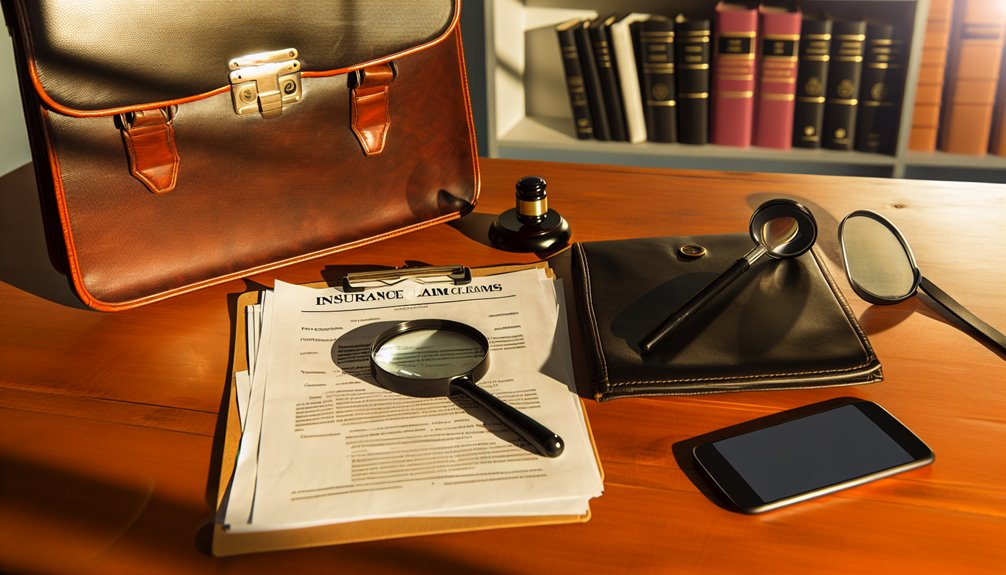Personal injury law lets you seek compensation when someone else’s negligence causes you harm. You’ll need to prove four key elements: the other party’s duty of care, their breach of that duty, how their actions caused your injury, and your resulting damages. Common claims include auto accidents, slip and falls, medical malpractice, and product liability. Success depends on gathering strong evidence through medical records, witness statements, and accident documentation. You’ll work with insurance companies and possibly attorneys through settlement negotiations or trial proceedings. Understanding each step of the process will greatly strengthen your position for fair compensation.
What Is Personal Injury Law

Personal injury law encompasses the legal framework that allows individuals to seek compensation when they’ve suffered harm due to someone else’s negligent or intentional actions. This area of civil law provides you with legal recourse to recover damages for physical injuries, emotional distress, and financial losses resulting from accidents or wrongful conduct.
As a personal injury overview reveals, you’ll find this field covers a broad spectrum of cases, including car accidents, slip and falls, medical malpractice, workplace injuries, and product liability.
The legal definitions within personal injury law establish specific elements you must prove to succeed in your claim: duty of care, breach of that duty, causation, and damages.
You’re entitled to seek various forms of compensation, including medical expenses, lost wages, pain and suffering, and in some cases, punitive damages.
It’s important to understand that personal injury claims operate under strict statutes of limitations, which vary by state and type of injury. While some cases settle through negotiation with insurance companies, others may require litigation in court to secure fair compensation for your losses.
Common Types of Personal Claims
Building on the fundamental principles of personal injury law, you’ll encounter several distinct categories of claims that commonly arise in legal practice. Understanding these categories will help you navigate the intricacies of personal injury cases and determine the most appropriate legal approach for your situation.
The legal system recognizes various types of personal injury claims, each with its own specific elements and requirements. Auto accidents represent the most frequent category, followed by premises liability cases involving slip accidents and unsafe property conditions. Medical malpractice claims arise when healthcare providers fail to meet the standard of care, while product liability cases target defective or dangerous consumer goods.
- Negligence-based claims: These include auto accidents, workplace injuries, and premises liability cases where someone’s carelessness causes harm.
- Professional misconduct claims: Medical malpractice cases fall here, often involving complex proof requirements.
- Intentional harm claims: Dog bites and assault cases that result in both physical injury and emotional distress.
- Catastrophic injury claims: Wrongful death cases and severe injuries that permanently impact the victim’s life.
Each type requires different evidence, legal standards, and strategic approaches to secure compensation.
Proving Fault and Liability

While establishing a personal injury case requires multiple elements, proving fault and liability stands as the fundamental aspect of a successful claim.
You’ll need to demonstrate that another party’s actions directly caused your injuries and that they’d a duty of care they failed to uphold.
To prove fault, you must establish four key components: duty, breach, causation, and damages.
The defendant must have owed you a duty of care, which varies based on negligence standards in your jurisdiction.
You’ll then need to show they breached this duty through action or inaction, and that this breach directly caused your injuries.
Understanding liability insurance becomes vital as you navigate your claim.
Most defendants will have insurance coverage, whether it’s auto insurance, homeowner’s policy, or commercial liability coverage.
You’ll need to identify all potentially liable parties and their respective insurance carriers.
Document everything that supports your case: photographs, witness statements, medical records, and expert testimonies.
These pieces of evidence help establish the chain of events and strengthen your position when proving both fault and damages.
Gathering Evidence For Your Case
You’ll need to methodically document every aspect of your injuries through detailed photographs, medical records, and a daily pain journal.
Your accident documentation should include police reports, witness statements, and any correspondence with insurance companies or other involved parties.
Preserving all evidence in chronological order will strengthen your personal injury claim and provide your attorney with the essential materials needed to build a compelling case.
Document Your Injuries Thoroughly
When pursuing a personal injury claim, thorough documentation of your injuries serves as the cornerstone of a strong case. Your injury documentation needs to be exhaustive, detailed, and chronological from the moment of the incident.
Take photographs of visible injuries immediately after the accident and continue documenting their progression through the healing process. Medical records form the foundation of your case’s value, so maintain a complete file of all healthcare visits, treatments, and prescribed medications.
Keep a daily journal detailing your pain levels, limitations, and how the injuries affect your daily activities. This contemporaneous record strengthens your claim by providing real-time evidence of your suffering and recovery journey.
Essential elements of injury documentation include:
- Detailed photographs of injuries from multiple angles, with clear timestamps
- All medical reports, bills, and correspondence from healthcare providers
- Daily pain and symptom journal entries, including medication effects
- Documentation of missed work days and lost income due to the injury
Remember to preserve all original documents and create digital backups. Your attorney will use this evidence to build a compelling case and accurately calculate your damages.
Preserve All Accident Records
Preserving three critical types of accident records can make or break your personal injury case: official documentation, witness information, and physical evidence. Your record retention strategy should begin immediately after the incident to guarantee nothing gets lost or forgotten.
For official documentation, collect police reports, medical records, insurance claim forms, and any correspondence with involved parties. Keep the original copies in a secure location and make digital backups. Don’t forget to save emergency room discharge papers, diagnostic test results, and treatment plans.
When it comes to witness information, maintain a detailed list of names, contact details, and their account of events. If possible, get written or recorded statements while memories are fresh. Take photos of the accident scene, your injuries, property damage, and relevant environmental conditions like weather or road hazards.
Physical evidence includes torn clothing, damaged personal items, vehicle parts, or any objects involved in the accident. Store these items carefully and document their condition with photographs.
Create a chronological file of all accident documentation, including receipts for medical expenses, repair costs, and any other accident-related expenditures. This organized approach will strengthen your case considerably.
Working With Insurance Companies

When dealing with insurance companies after a personal injury, you’ll need to maintain detailed records of every phone call, email, and written correspondence to protect your interests.
You must carefully evaluate any settlement offers, considering both current and future costs associated with your injury before accepting or negotiating for a more appropriate amount.
If the insurance company denies your claim or offers an inadequate settlement, you’re entitled to file an appeal, which often requires additional documentation and a thorough understanding of the appeals process.
Documenting All Insurance Communications
Maintaining detailed records of all insurance communications serves as a critical safeguard in personal injury cases. You’ll need to implement effective communication strategies that protect your interests while building a documented trail of all interactions.
Every piece of insurance correspondence should be preserved and organized chronologically, including emails, letters, phone call summaries, and text messages.
When documenting your insurance communications, follow these essential practices:
- Create a dedicated folder (physical or digital) for storing all written communications, including dated notes from phone conversations
- Record the full name, title, and contact information of every insurance representative you speak with
- Take detailed notes during calls, including time, date, and specific promises or statements made
- Save all emails and text messages in their original format, maintaining metadata and timestamps
Remember that thorough documentation can greatly strengthen your position during negotiations or potential litigation.
If disputes arise about what was said or promised, you’ll have concrete evidence to support your claims. This systematic approach to tracking insurance communications helps prevent misunderstandings and protects your legal rights throughout the claims process.
Handling Settlement Offer Negotiations
Settlement offer negotiations represent a critical phase where your documented communications become valuable leverage.
When evaluating initial offers, you’ll need to assess both economic and non-economic damages while maintaining a clear understanding of your case’s true value. Don’t accept the first offer, as it’s typically lower than your claim’s worth.
Effective settlement strategies include presenting compelling evidence, highlighting the strength of your medical documentation, and demonstrating how the injury has impacted your life.
You’ll want to respond to each offer in writing, clearly stating why it’s insufficient and providing specific reasons backed by evidence. Your negotiation tactics should remain professional yet firm, focusing on facts rather than emotional appeals.
If you’re working with an attorney, they’ll implement proven techniques to counter lowball offers and may use similar case settlements as benchmarks.
Remember to calculate future medical expenses and long-term impacts before agreeing to any settlement.
Don’t feel pressured to accept an offer quickly – insurance companies often increase their proposals when met with well-documented resistance and solid counteroffers.
Keep detailed records of all negotiation communications and maintain patience throughout the process.
Filing Insurance Claim Appeals
Although insurance companies may deny your initial claim, you have the right to appeal their decision through a formal review process. Understanding insurance claim processes and following proper appeal submission guidelines will greatly increase your chances of success.
When filing an appeal, you’ll need to gather additional evidence, documentation, and expert opinions that strengthen your case. The appeal must clearly demonstrate why the insurance company’s denial was incorrect based on policy terms and applicable laws.
Key steps for filing an effective insurance claim appeal:
- Review your denial letter carefully to understand the specific reasons for rejection and identify any deadlines for submitting your appeal.
- Collect new medical records, expert testimonies, or accident reports that support your position and address the insurer’s concerns.
- Draft a detailed appeal letter that systematically addresses each reason for denial with supporting evidence.
- Submit your appeal package within required timeframes and maintain copies of all correspondence.
If your appeal is denied, you may have options for further review through state insurance regulators or legal action. Consider consulting with a personal injury attorney who can evaluate your case and recommend the most appropriate course of action.
Calculating Damages and Compensation
When determining the value of a personal injury claim, courts consider multiple categories of damages that you may be entitled to recover. The two main categories include economic and non-economic damages, each serving a distinct purpose in your compensation.
Economic factors encompass tangible losses you’ve incurred, including medical bills, lost wages, property damage, and future treatment costs. You’ll need to document these expenses carefully through medical records, receipts, and expert testimony to support your claim.
Don’t forget to factor in long-term rehabilitation costs and potential loss of earning capacity.
Non-economic damages address emotional damages and intangible losses you’ve suffered. These include pain and suffering, mental anguish, loss of enjoyment of life, and emotional distress. While harder to quantify, they’re often calculated using multiplier methods or per diem approaches.
You’ll want to maintain a detailed journal documenting how your injuries affect your daily life.
In some cases, you may also be eligible for punitive damages if the defendant’s actions were particularly reckless or malicious. Your attorney can help you assess which damages apply to your case and develop a thorough strategy to maximize your compensation.
Legal Deadlines and Time Limits

Understanding your time limits represents one of the most critical aspects of pursuing a personal injury claim. The statute of limitations sets strict deadlines for when you must file your case, and if you miss these deadlines, you’ll likely lose your right to seek compensation entirely.
Each state maintains different filing deadlines for personal injury cases, typically ranging from one to six years from the date of injury. However, certain factors can affect these timeframes:
- Discovery of injury – The clock may start when you discover the injury rather than when it occurred
- Government entities – Claims against public institutions often have shorter deadlines
- Minor plaintiffs – The statute of limitations usually doesn’t begin until the victim turns 18
- Defendant’s absence – The timeline might pause if the defendant leaves the state
You’ll need to act quickly to preserve your legal rights. Start by documenting everything related to your injury and consulting with an attorney as soon as possible.
They’ll help guarantee you meet all critical filing deadlines and protect your ability to pursue compensation. Remember, waiting too long can permanently bar you from seeking damages, regardless of how strong your case might be.
Choosing the Right Attorney
Selecting an experienced personal injury attorney can make or break your case’s outcome. When evaluating potential lawyers, you’ll need to examine their track record, specialization, and resources to handle your specific type of injury claim.
Start by verifying attorney qualifications, including their state bar standing, years of experience in personal injury law, and trial experience. Look for lawyers who regularly handle cases similar to yours, whether it’s a car accident, workplace injury, or medical malpractice claim.
Don’t hesitate to ask about their success rate and average settlement amounts.
Review client testimonials and case results to gauge their reputation and effectiveness. A reliable attorney should provide references and maintain transparency about their previous outcomes.
You’ll also want to confirm their fee structure, typically working on a contingency basis where they only get paid if you win.
During initial consultations, assess their communication style and willingness to explain complex legal concepts. Your attorney should demonstrate both legal expertise and genuine concern for your situation.
Pay attention to whether they’ve adequate staff and resources to properly investigate and pursue your claim.
Settlement Negotiations and Mediation

Once you’ve secured qualified legal representation, the focus shifts to settlement negotiations and mediation – processes that resolve most personal injury cases before trial.
Your attorney will employ various negotiation strategies to engage with insurance companies and opposing counsel while protecting your interests. During this phase, it’s essential to understand how mediation techniques can facilitate productive discussions and lead to fair settlements.
The mediation process typically involves a neutral third party who helps both sides reach an agreement. You’ll need to actively participate by providing necessary information and considering reasonable offers.
Your attorney will guide you through evaluating settlement proposals based on:
- The strength of your evidence and liability claims
- Your documented medical expenses and future care needs
- Lost wages and impact on earning capacity
- Pain and suffering calculations based on similar cases
If initial negotiations don’t yield satisfactory results, formal mediation often provides a structured environment for resolution.
During mediation sessions, you’ll have opportunities to present your case while exploring creative solutions. Your attorney’s experience with negotiation strategies becomes particularly valuable as they work to maximize your compensation while avoiding costly litigation.
Going to Trial
When your personal injury case proceeds to trial, you’ll need to work closely with your attorney to gather and organize all relevant evidence, including medical records, expert testimony, and documentation of damages.
Your legal team will develop a compelling trial strategy, prepare witnesses, and craft opening and closing statements that effectively communicate your case to the judge or jury.
During the trial itself, you’ll see your attorney present evidence methodically through witness examinations, exhibit displays, and expert testimony while adhering to court procedures and rules of evidence.
Trial Preparation Steps
Before a personal injury case reaches the courtroom, extensive trial preparation must occur to maximize your chances of success. Your attorney will develop a detailed trial strategy, focusing on building compelling arguments and anticipating potential counterarguments from the defense.
Witness preparation becomes vital during this phase, as your legal team works to guarantee all testimonies are clear, accurate, and effectively support your case.
You’ll need to actively participate in the preparation process by:
- Reviewing and organizing all medical records, bills, and documentation related to your injury
- Practicing your testimony with your attorney to confirm you’re comfortable answering questions under pressure
- Meeting with expert witnesses who’ll testify about technical aspects of your case
- Helping identify and gather any additional evidence that strengthens your position
During this preparation phase, your attorney will also draft and file necessary pre-trial motions, prepare exhibits, and develop persuasive opening and closing statements.
You’ll work together to refine the presentation of evidence and guarantee all legal requirements are met before stepping into the courtroom. This thorough preparation helps establish a strong foundation for your case and increases the likelihood of a favorable outcome.
Evidence Presentation in Court
The effective presentation of evidence in court marks a defining moment in your personal injury case. During the trial, you’ll need to present various evidence types that support your claim for damages. This includes physical evidence, medical records, expert reports, photographs, surveillance footage, and witness testimony that collectively establish liability and demonstrate the extent of your injuries.
Your attorney will systematically introduce each piece of evidence following strict court procedures and rules of evidence. You’ll find that witness testimony plays an essential role, as both lay witnesses and expert witnesses take the stand to provide their accounts and professional opinions. Medical experts may testify about your injuries and prognosis, while accident reconstruction specialists might explain how the incident occurred.
During cross-examination, you’ll need to defend your evidence against opposing counsel’s challenges. It’s vital that your evidence remains consistent with your pre-trial statements and documentation. Your attorney will also object to inadmissible evidence presented by the defense while defending against their objections to your evidence.
Remember that each piece of evidence must contribute to proving the key elements of your personal injury claim: duty, breach, causation, and damages.
Frequently Asked Questions
Can I Still File a Claim if I Was Partially at Fault?
Yes, you can still file a claim even if you’re partially at fault, but your compensation may be reduced.
Most states follow comparative negligence rules, which allow you to recover damages based on your percentage of fault. For example, if you’re found 30% responsible for an accident, you’ll receive 70% of the total damages.
However, fault determination can be complex, so it’s essential to document evidence and consider legal representation.
What Should I Do if the Other Party’s Insurance Company Calls Me?
Don’t let the insurance company’s siren song lure you into dangerous waters.
When they call, politely decline to give a recorded statement or discuss details. Instead, inform them you’ll have your attorney handle all insurance negotiations.
Document the call’s date, time, and representative’s name for your records. Until you’ve sought legal counsel, any statements you make could jeopardize your claim.
How Long Will My Personal Injury Case Take to Resolve?
Your case duration can range from several months to multiple years depending on key resolution factors.
You’ll typically see faster settlements if liability is clear and your injuries are straightforward.
Complex cases involving severe injuries, disputed fault, or multiple parties will take longer to resolve.
If your case goes to trial rather than settling, you can expect the process to last 1-3 years, sometimes longer in complicated situations.
Will I Have to Pay Taxes on My Personal Injury Settlement?
The tax implications of your personal injury settlement depend on the settlement types you receive. Generally, you won’t have to pay taxes on compensation for physical injuries or physical sickness.
However, you’ll need to pay taxes on punitive damages, interest on judgments, and portions of settlements allocated to emotional distress without physical injury.
It’s crucial to consult a tax professional, as they can help you understand specific tax obligations for your settlement components.
Can I Switch Attorneys in the Middle of My Personal Injury Case?
Patiently pursuing your personal injury path means you’re permitted to switch attorneys at any time – it’s your legal right.
However, you’ll need to weigh potential complications with attorney fees, as your previous lawyer may place a lien on your case for work already completed.
A switch could also impact your case timeline, potentially causing delays.
Before making this decision, you should clearly communicate your concerns with your current attorney and understand the financial implications.
Conclusion
Personal injury law requires strategic navigation and decisive action to secure fair compensation. Consider the landmark case Smith v. Johnson (2019), where detailed medical documentation and expert testimony led to a $2.4M settlement for traumatic brain injury. You’ll need to act swiftly within statutes of limitation, maintain thorough evidence, and leverage professional legal expertise. Whether negotiating with insurers or proceeding to trial, your understanding of these fundamentals will strengthen your position.
